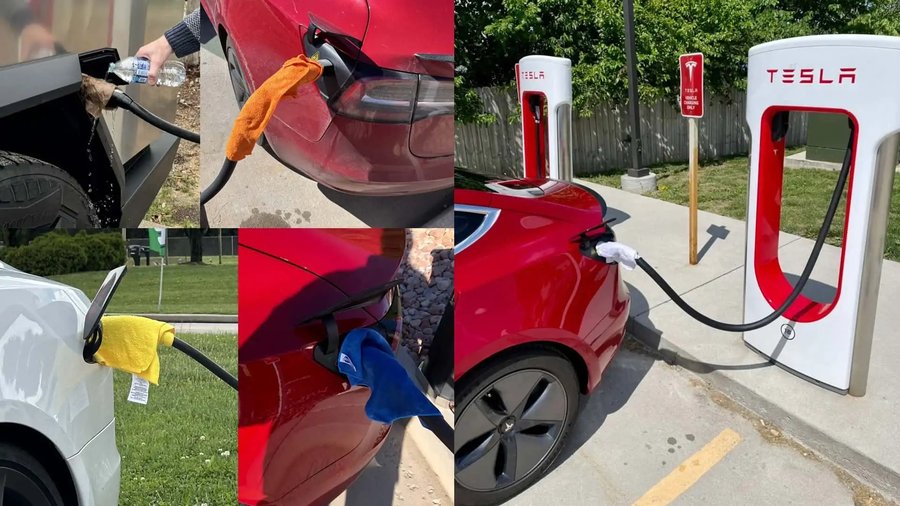Tesla Owners Are Putting Wet Towels On Supercharger Handles To Get Higher Charging Speeds

Everybody who knows EVs knows that extreme temperatures and high charging speeds don’t usually mix well. But some Tesla owners discovered that they can trick the system on hot, sunny days to get a little extra juice from a Supercharger station and save a few minutes during a top-up session. And believe it or not, it really seems to work—yet that doesn't mean you should do it.
The wet towel trick has circulated on Tesla forums and other online communities for a few years now, but with summer coming in hot, we thought it would be a good idea to bring it into the spotlight once again.
Yet Tesla has been adamant that this presents a safety risk, and while it's become a common hack, the company strongly recommends against it. Here's what the automaker said in rare response to this story:
As its name suggests, it implies putting a wet piece of cloth over the charging cable handle. This is especially useful during a hot day when the sun shines directly on the handle, making its temperature rise. On older, V2 Supercharger stalls that don’t have actively cooled cables, the handle can get hot very quickly.
As a result, the sensor that’s inside the handle tells the charger to lower the charging speed so that a safe temperature can be maintained. But by putting a wet towel over the handle, it’s shielded from the sun’s light and can stay at a lower temperature, thus facilitating a higher charging rate. Just to reiterate, though, this cools the handle which would otherwise be too hot to the touch.
One Tesla owner documented that putting a damp cloth over the charging handle convinced the V2 Supercharger to up the rate from 60 kilowatts to 95 kW during a hot day. Meanwhile, our friends at Out of Spec Studios experienced an even better result.
They plugged in at a 2% state of charge and the Supercharger quickly ramped up to 147 kW, but then it thermal throttled to just 58 kW when the state of charge reached 34%. Putting a wet rag at room temperature over the cable handle convinced the stall to ramp back up to 119 kW.
On the newer, V3 stalls, this trick won’t help at all on almost all of Tesla’s EVs, except the Cybertruck. The angular pickup is the company’s first passenger vehicle to feature an 800-volt battery setup (the others have a 400V system), but all the Supercharger stations that are currently online in the United States aren’t capable of dispensing at 800V.
As a result, the electric pickup splits the battery pack into two 400V sub-units, making the Superchargers ramp up the electrical current rate to over 700 amps. This can make even the actively cooled V3 handle get hot, which is why the wet towel trick only works for Cybertruck owners who go to V3 stalls to top up their batteries.
That said, prolific EV driver Branden Flasch said on X that he noticed a slight improvement in the charging curve while using the DIY trick on a Tesla Model S that was hooked up to a V3 DC fast charger, so it might come in handy for other Tesla owners, too.
It’s worth noting, however, that whatever the Supercharger version, this slightly unorthodox solution will only do so much to improve the charging experience. The charging rate will still taper when the state of charge gets closer to 100%, so it’s no magic bullet. It's also an unsanctioned solution, so use it at your own risk.
As for the safety concerns that some owners threw into the online discussions that popped up over the years, here's what you need to know. For starters, Tesla’s Superchargers are more than capable of working safely when it rains, so a damp cloth shouldn’t do any harm.
Then, the cars themselves can monitor the temperature of the charging pins (plus a few other monitoring spots along the charging route), so even if the charging cable handle is artificially cooled, the car will still instruct the dispenser to slow down the flow of current to keep everything safe if there's an issue.
With all this being said, this method isn't recognized or recommended by Tesla, so you should use it at your own risk. Or not at all, especially during the hotter summer months.
This article was updated after it was published to include a rare response from Tesla, and to stress that the automaker recommends the method be avoided for safety reasons.
